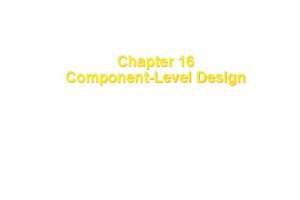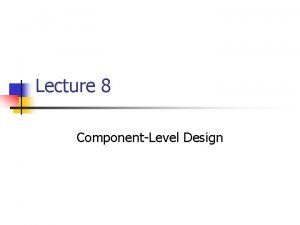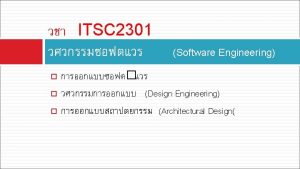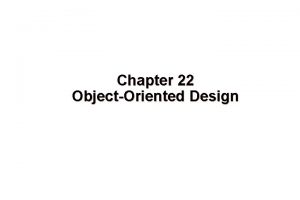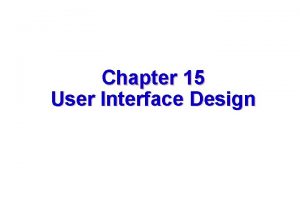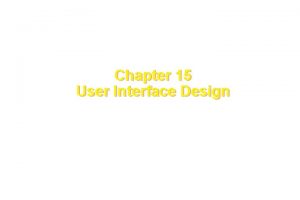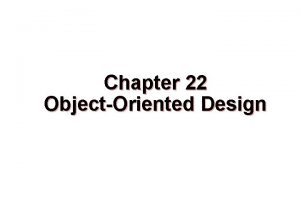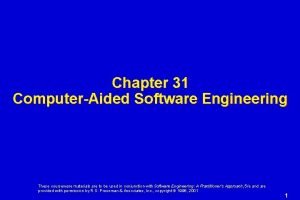Chapter 16 ComponentLevel Design These courseware materials are









- Slides: 9

Chapter 16 Component-Level Design These courseware materials are to be used in conjunction with Software Engineering: A Practitioner’s Approach, 5/e and are provided with permission by R. S. Pressman & Associates, Inc. , copyright © 1996, 2001 1

Component-Level Design the closest design activity to coding the approach: review the design description for the component use stepwise refinement to develop algorithm use structured programming to implement procedural logic use ‘formal methods’ to prove logic These courseware materials are to be used in conjunction with Software Engineering: A Practitioner’s Approach, 5/e and are provided with permission by R. S. Pressman & Associates, Inc. , copyright © 1996, 2001 2

Stepwise Refinement open walk to door; reach for knob; open door; walk through; close door. repeat until door opens turn knob clockwise; if knob doesn't turn, then take key out; find correct key; insert in lock; endif pull/push door move out of way; end repeat These courseware materials are to be used in conjunction with Software Engineering: A Practitioner’s Approach, 5/e and are provided with permission by R. S. Pressman & Associates, Inc. , copyright © 1996, 2001 3

The Component-Level Design Model represents the algorithm at a level of detail that can be reviewed for quality options: graphical (e. g. flowchart, box diagram) pseudocode (e. g. , PDL). . . choice of many programming language decision table conduct walkthrough to assess quality These courseware materials are to be used in conjunction with Software Engineering: A Practitioner’s Approach, 5/e and are provided with permission by R. S. Pressman & Associates, Inc. , copyright © 1996, 2001 4

Structured Programming for Procedural Design uses a limited set of logical constructs: sequence conditional — if-then-else, select-case loops — do-while, repeat until leads to more readable, testable code important for achieving high quality, but not enough These courseware materials are to be used in conjunction with Software Engineering: A Practitioner’s Approach, 5/e and are provided with permission by R. S. Pressman & Associates, Inc. , copyright © 1996, 2001 5

A Structured Procedural Design These courseware materials are to be used in conjunction with Software Engineering: A Practitioner’s Approach, 5/e and are provided with permission by R. S. Pressman & Associates, Inc. , copyright © 1996, 2001 6

Program Design Language (PDL) These courseware materials are to be used in conjunction with Software Engineering: A Practitioner’s Approach, 5/e and are provided with permission by R. S. Pressman & Associates, Inc. , copyright © 1996, 2001 7

Why Design Language? These courseware materials are to be used in conjunction with Software Engineering: A Practitioner’s Approach, 5/e and are provided with permission by R. S. Pressman & Associates, Inc. , copyright © 1996, 2001 8

OO vs Structured Techniques need PDL’s and other techniques to define how the processes interact. These items get in the way of good OO designers need a pseudo code, collaboration diagram, sequence diagram to define how classes will collaborate only to assure that they have received all the user information the need. These courseware materials are to be used in conjunction with Software Engineering: A Practitioner’s Approach, 5/e and are provided with permission by R. S. Pressman & Associates, Inc. , copyright © 1996, 2001 9
 Insidan region jh
Insidan region jh 2013 cci learning
2013 cci learning Myfloridareadytowork
Myfloridareadytowork Win career readiness courseware
Win career readiness courseware Cant stop the feeling trolls go noodle
Cant stop the feeling trolls go noodle Useful materials and harmful materials
Useful materials and harmful materials Man made materials
Man made materials Adopting and adapting teaching materials
Adopting and adapting teaching materials Direct materials budget with multiple materials
Direct materials budget with multiple materials Identifying materials that block light
Identifying materials that block light










